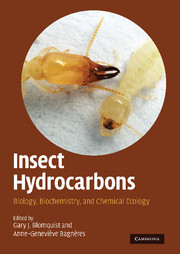Book contents
- Frontmatter
- Contents
- List of contributors
- Foreword
- Acknowledgments
- Part I Chemistry, Biochemistry, and Physiology
- Part II Chemical Communication
- 10 Perception and olfaction of cuticular compounds
- 11 Nestmate recognition in social insects and the role of hydrocarbons
- 12 Cuticular hydrocarbon cues in the formation and maintenance of insect social groups
- 13 Hydrocarbon profiles indicate fertility and dominance status in ant, bee, and wasp colonies
- 14 Chemical deception/mimicry using cuticular hydrocarbons
- 15 Behavioral and evolutionary roles of cuticular hydrocarbons in Diptera
- 16 Contact recognition pheromones in spiders and scorpions
- 17 Hydrocarbons as contact pheromones of longhorned beetles (Coleoptera: Cerambycidae)
- 18 Polyene hydrocarbons, epoxides, and related compounds as components of lepidopteran pheromone blends
- 19 Volatile hydrocarbon pheromones from beetles
- 20 Future directions in hydrocarbon research
- Index
13 - Hydrocarbon profiles indicate fertility and dominance status in ant, bee, and wasp colonies
from Part II - Chemical Communication
Published online by Cambridge University Press: 18 May 2010
- Frontmatter
- Contents
- List of contributors
- Foreword
- Acknowledgments
- Part I Chemistry, Biochemistry, and Physiology
- Part II Chemical Communication
- 10 Perception and olfaction of cuticular compounds
- 11 Nestmate recognition in social insects and the role of hydrocarbons
- 12 Cuticular hydrocarbon cues in the formation and maintenance of insect social groups
- 13 Hydrocarbon profiles indicate fertility and dominance status in ant, bee, and wasp colonies
- 14 Chemical deception/mimicry using cuticular hydrocarbons
- 15 Behavioral and evolutionary roles of cuticular hydrocarbons in Diptera
- 16 Contact recognition pheromones in spiders and scorpions
- 17 Hydrocarbons as contact pheromones of longhorned beetles (Coleoptera: Cerambycidae)
- 18 Polyene hydrocarbons, epoxides, and related compounds as components of lepidopteran pheromone blends
- 19 Volatile hydrocarbon pheromones from beetles
- 20 Future directions in hydrocarbon research
- Index
Summary
The social organization of insect colonies indicates the importance of information that is usually not needed in solitary insects. Information about the presence and fertility of a queen strongly affects worker behavior and colony organization. Reproductive competition in colonies requires the correct assessment of each others' rank. All of this information about fertility status and/or dominance status can be encoded in the cuticular hydrocarbon profile of members of ant, wasp, and bee colonies. Understanding variations in these hydrocarbon profiles, their composition, and relation to fertility is key to the further understanding of the major property of eusocial insects, reproductive division of labor.
Cuticular hydrocarbons are part of the lipid layer of the insect cuticle that protects from desiccation (Lockey, 1988) and are thus present in basically every social insect (see Chapter 6). Insects have the sensory apparatus to detect these profiles. So it is not surprising that they utilize variations in hydrocarbon profiles between individuals within and between species to detect various properties in other individuals, such as species identity, gender, colony membership (Howard and Blomquist, 1982, 2005; and various chapters in Part II of this book). In this chapter I will review the evidence indicating that hydrocarbon profiles are also used in colonies of ants, bees, and wasps for the regulation of reproduction. I will especially focus on patterns of variation in hydrocarbon profiles on the cuticle and the eggs in relation to fertility differences, which has not been done in such detail in previous reviews (Heinze, 2004; Monnin, 2006; Hefetz, 2007; Le Conte and Hefetz, 2008; Peeters and Liebig, 2009).
- Type
- Chapter
- Information
- Insect HydrocarbonsBiology, Biochemistry, and Chemical Ecology, pp. 254 - 281Publisher: Cambridge University PressPrint publication year: 2010
- 77
- Cited by

